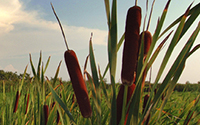Native Plants
Nearly 3,000 plant species present in Florida are considered native. The majority of them are terrestrial plants: they live on dry land. There are also hundreds of aquatic plant species that live in damp or wet soils or in the water.
Native plants are a valuable part of the environment because they have evolved with it. Native plants provide food and shelter to native animals, and stability to the multitude of habitats found in Florida. Because a single native plant species usually does not dominate an area, there is biodiversity. These ecological niches come with their own checks and balances. Each native plant and animal species is constrained by natural factors, such as competition with other native species, plant diseases, predation by insects and other animals, and the local climate.


 Native plants are not usually considered a problem in their native ranges. However, when an area is disturbed by activities such as construction, ditching, drainage, pumping systems, or dams–or when excessive amounts of fertilizer enter a water body–certain native plants may become the dominant species. For example, native cattails (Typha spp.) can quickly fill disturbed wet areas and are sometimes controlled by plant management agencies. They are often the predominant plant in constructed ponds and ditches. In the Everglades, cattails can crowd out desirable saw grass (Cladium jamaicense) that produces food and habitat for native wildlife. Alterations in water-level fluctuations and nutrient input by humans may have provided an advantage to cattails over saw-grass in certain areas.
Native plants are not usually considered a problem in their native ranges. However, when an area is disturbed by activities such as construction, ditching, drainage, pumping systems, or dams–or when excessive amounts of fertilizer enter a water body–certain native plants may become the dominant species. For example, native cattails (Typha spp.) can quickly fill disturbed wet areas and are sometimes controlled by plant management agencies. They are often the predominant plant in constructed ponds and ditches. In the Everglades, cattails can crowd out desirable saw grass (Cladium jamaicense) that produces food and habitat for native wildlife. Alterations in water-level fluctuations and nutrient input by humans may have provided an advantage to cattails over saw-grass in certain areas.